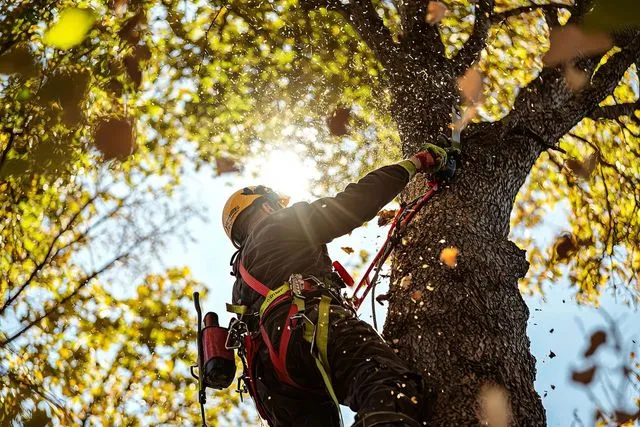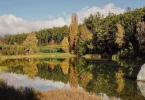A single overlooked weakness in a tree can turn a quiet yard into a hazardous space. Decay hidden inside the trunk, compacted soil around the roots, or structural imbalances in the canopy reduce strength long before collapse is visible. These problems often escape untrained eyes, yet arborists detect them quickly through specialized knowledge of tree biology, structure, and long-term growth patterns. Their expertise protects property, preserves landscapes, and strengthens community safety.
With stronger storms and more homes built near large, mature trees, early detection has never been more important. Homeowners who learn to notice subtle changes—such as bark shifts, canopy lean, or soil problems—avoid costly surprises while helping their trees remain safe, resilient, and valuable for decades.
Contents
Structural Red Flags Hidden in the Canopy
High in the crown, a narrow V between stems often hides included bark, forming a seam that can split under stress. Small cracks at junctions expand with wind or ice, while uneven branch weight gradually throws the trunk off balance. Co-dominant stems share the same support tissue, weakening structure, and overextended limbs act like levers that speed up decay.
From the ground, arborists interpret sway patterns, canopy symmetry, and tight angles to uncover hidden weakness. Sounding and probing confirm concerns. Homeowners who rely on expert tree service Seattle professionals benefit from early pruning that redistributes weight, while scheduled inspections every few years catch dangerous unions before sudden failure.
Soil and Root Warning Signs That Go Unnoticed
Waterlogged soil around a trunk often signals more than heavy rain—it reveals drainage failures that slowly weaken roots and shorten a tree’s life. Compaction from pavement, heavy foot traffic, or thick mulch further reduces oxygen flow, restricting healthy growth. These stresses often remain invisible until the crown shows decline or the tree begins losing stability.
Roots injured by mowing blades or repeated traffic gradually lose strength. Small wounds compound over time, leading to leaning trunks, sidewalk cracks, and weakened anchorage. Arborists use simple tools like soil probes or screwdrivers to detect compaction, guiding decisions about aeration or root protection. Early awareness turns hidden threats into manageable, cost-saving solutions.
Disease Clues in Leaves, Twigs, and Bark
Speckled or chlorotic patches on leaves, subtle wilting at branch tips, and tiny necrotic spots often show before whole limbs decline. Browning twig clusters at shoot ends point to systemic stress; ribboned or sunken bark, oozing sap, and fungal conks signal compromised internal tissues. Such signs can be intermittent and easy to miss; watch for matching symptoms across nearby trees.
Arborists check the leaf underside, examine twig cross-sections for pith discoloration, and trace cankers along bark seams to pinpoint pathogens or vascular blockages. Early identification narrows treatment options and improves recovery odds. Weekly photographs and notes using a pocket magnifier work well.
Growth Patterns That Create Property Risks
Mature trees often develop growth patterns that gradually create risks for nearby property. Branches that rub against rooftops or siding speed up wear, trap moisture, and create openings for insects. A leaning trunk heightens the chance of collapse toward driveways, walkways, or other high-use spaces where people or vehicles are often present.
Underground, roots extend outward with equal force. Over time, they can lift sidewalks, crack slabs, and interfere with underground utilities. Arborists recommend proactive planning, including keeping major limbs at least ten feet from power lines and several feet from rooftops. Regular inspections after storms reduce long-term surprises and preserve tree stability.
Lasting Stress From Poor Tree Work in the Past
Splintered collars, ragged stub cuts, and flush pruning scars reveal rushed work that invites decay. Trees respond slowly: poorly healed wounds, internal rot, and epicormic shoots often expose past topping or over-thinning. Such scars leave crowns thinner, regrowth tighter, and wind resistance weaker, while root loss from trenching or construction quietly erodes anchorage.
Arborists study cut angles, exposed heartwood, and uneven callus growth to assess past practices. Stub cuts, sunken bark, and brittle re-sprouts that snap under load are red flags when considering treatment or removal. Smoothly transitioning from diagnosis to prevention, arborists recommend inspections every three to five years to detect lingering structural stress before it becomes urgent.
Healthy trees require both careful observation and timely care. Subtle changes in bark, leaves, roots, and canopy structure reveal problems that can be corrected before they lead to costly failures. Seasonal walkarounds and simple photographs give homeowners a clear record of change, while professional evaluations every few years add expert insight. This steady balance of awareness and response protects property, reduces expenses, and preserves the strength of mature trees. Even a brief check after storms can reveal the first signs of stress. With consistent attention, trees remain long-term guardians of safety, beauty, and property value in every community.







